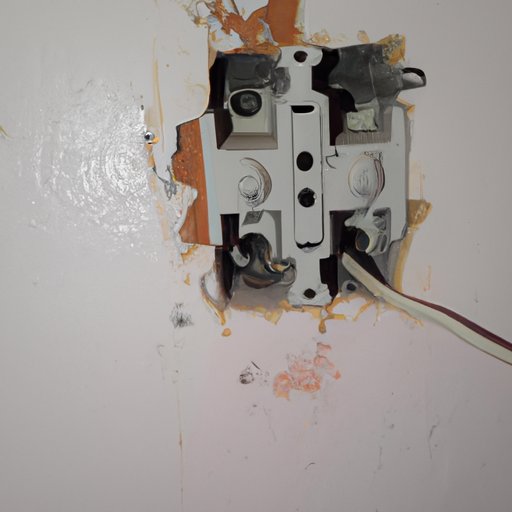Introduction
When a breaker trips, it can be a daunting task to figure out why and how to fix it. Fortunately, understanding what is causing the issue and how to solve it is not as difficult as it may seem. This article will provide an overview of the steps you should take to identify the cause of the tripped breaker and how to reset it, as well as tips on upgrading to a larger breaker and installing Ground Fault Circuit Interrupter (GFCI) outlets.
What is a Tripped Breaker?
A tripped breaker occurs when an electrical circuit experiences a surge in current that exceeds its capacity. When this happens, the breaker trips, or shuts off power to that circuit, to prevent further damage to the wiring, appliances, and other electrical components.
Why Do Breakers Trip?
Breakers trip for a variety of reasons, including overloaded circuits, faulty wiring, and short circuits. You should inspect the wiring and check for any defective equipment before attempting to reset the breaker.
Identify the Cause of a Tripped Breaker
Before you attempt to reset the breaker, it’s important to identify the cause of the tripped breaker. The following steps will help you determine the source of the problem.
Check for Overloaded Circuits
One of the most common causes of a tripped breaker is an overloaded circuit. If the circuit is overloaded with too many appliances or devices, it can cause a surge in current that will trip the breaker. To prevent this from happening, distribute the load evenly among different circuits.
Inspect Wiring for Defects
It’s also important to inspect the wiring for any defects. Loose connections, damaged insulation, and other problems can cause a surge in current and trip the breaker. If you find any issues with the wiring, you should have an electrician repair it before attempting to reset the breaker.
Reset the Breaker
Once you’ve identified and addressed the source of the tripped breaker, you can reset it. The following steps will help you do so.
Locate the Circuit Breaker Panel
The first step is to locate the circuit breaker panel. It is usually located in the basement, garage, or utility room of your home. Once you have located it, make sure all the breakers are switched to the “off” position.
Reset the Breaker
To reset the breaker, switch it to the “on” position. If the breaker trips again, it is likely due to an underlying issue. In this case, you should consult an electrician for help.
Replace the Breaker
If the breaker continues to trip even after resetting it, it may be time to replace it. The following steps will help you do so.
Determine the Correct Size Breaker
Before replacing the breaker, you’ll need to determine the correct size. Make sure the new breaker is rated for the same amount of current as the old one. If the new breaker is too large, it could cause a fire.
Install the New Breaker
Once you have the correct size breaker, you can install it. Turn off the main power before removing the old breaker and installing the new one. Then, turn the main power back on and test the new breaker.

Upgrade to a Larger Breaker
If the circuit is regularly being overloaded, you may want to consider upgrading to a larger breaker. The following steps will help you do so.
Determine the Power Requirements
Before you upgrade to a larger breaker, you’ll need to determine the power requirements of the circuit. This will ensure the new breaker is properly sized for the circuit.
Install the Larger Breaker
Once you have determined the power requirements, you can install the larger breaker. Follow the same steps outlined above for replacing the breaker, but make sure the new breaker is rated for the correct amount of current.
Install GFCI Outlets
Ground Fault Circuit Interrupter (GFCI) outlets are designed to detect ground faults and shut off power if they occur. Installing GFCI outlets on circuits that are prone to tripping can help reduce the risk of electrical shock and fires.
Types of GFCI Outlets
GFCI outlets come in two types: self-test and non-self-test. Self-test outlets periodically test themselves to ensure they are functioning properly, while non-self-test outlets require manual testing.
Installation Process
Installing GFCI outlets requires some knowledge of electrical wiring. If you’re not experienced in this area, it’s best to consult an electrician for help. They will be able to install the outlets correctly and safely.
Conclusion
Understanding what to do when a breaker trips is essential for keeping your home safe and your electrical system functioning properly. By following the troubleshooting tips outlined in this article, you can identify the cause of the tripped breaker and reset it. Additionally, you can upgrade to a larger breaker and install GFCI outlets to help prevent future issues.
(Note: Is this article not meeting your expectations? Do you have knowledge or insights to share? Unlock new opportunities and expand your reach by joining our authors team. Click Registration to join us and share your expertise with our readers.)
